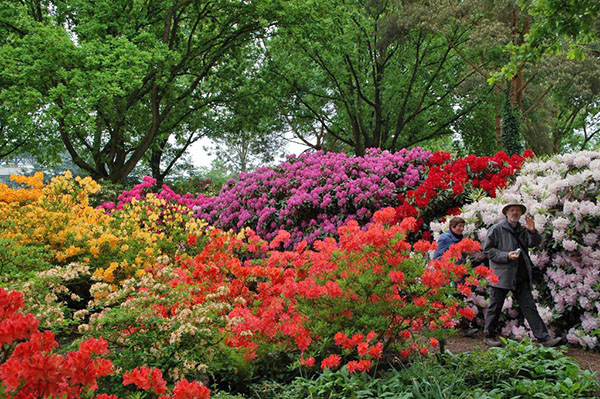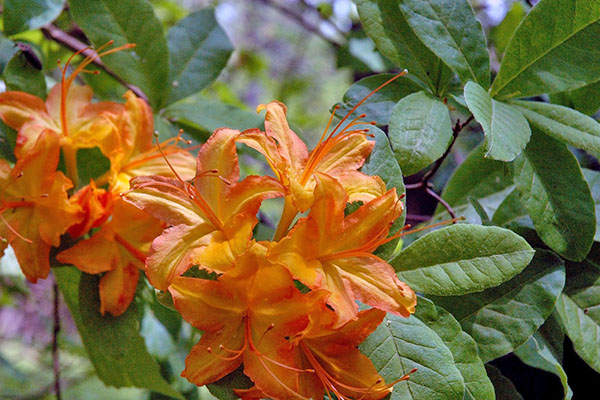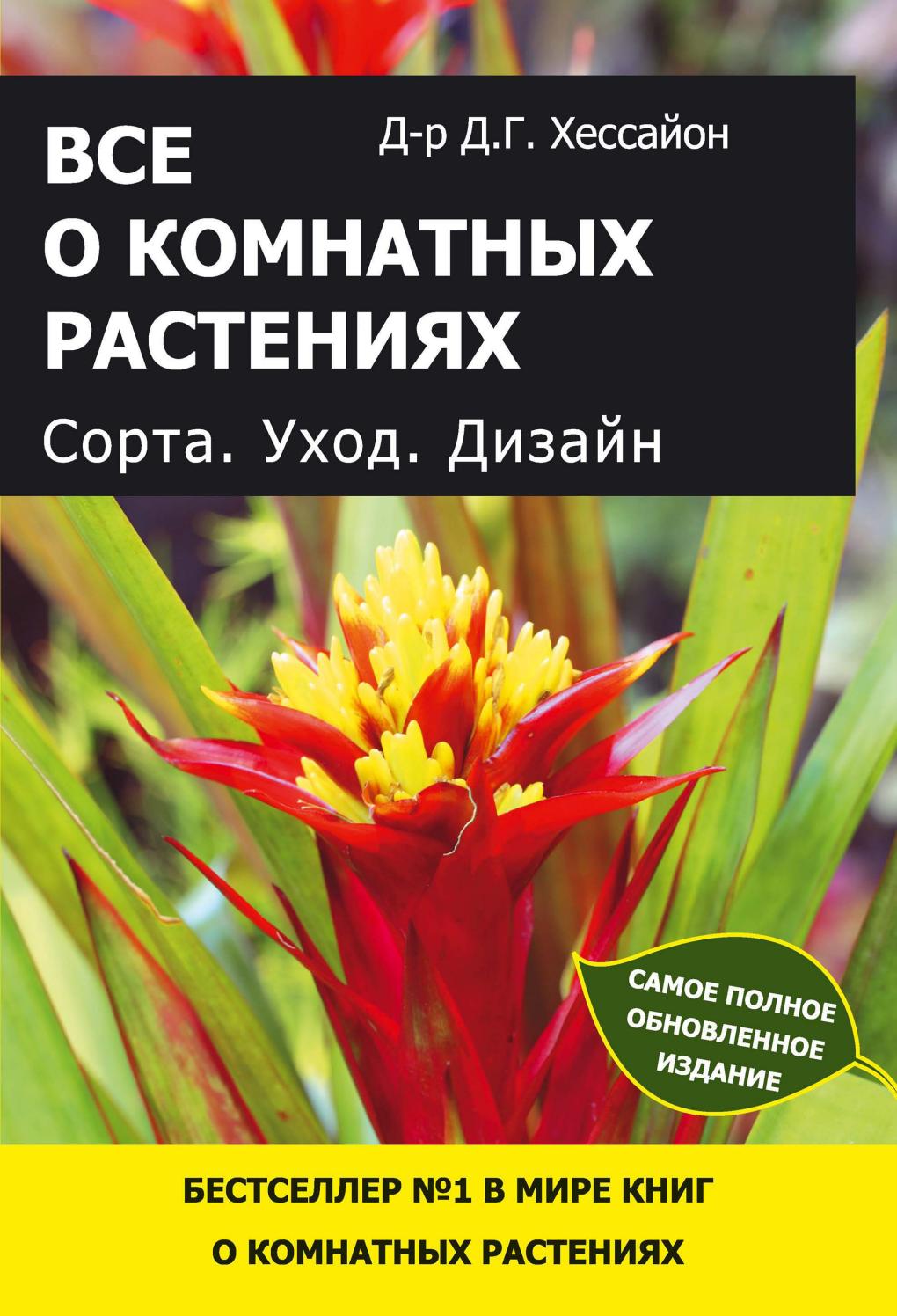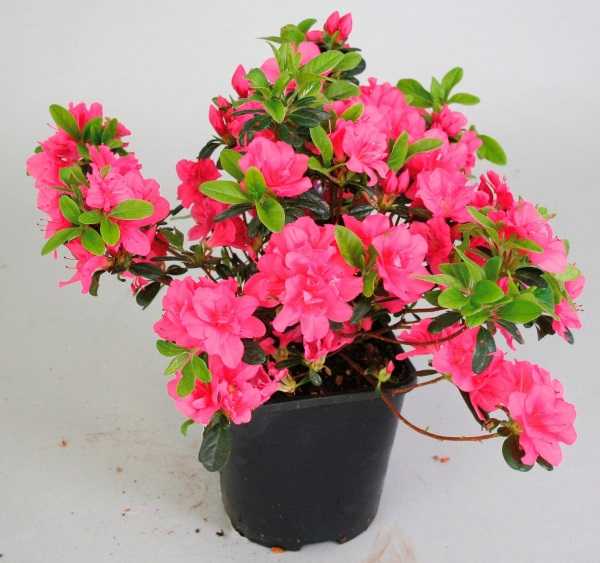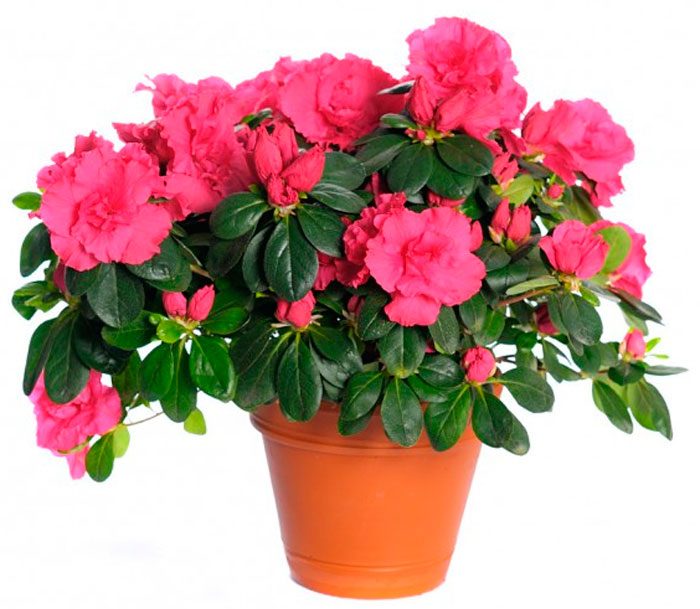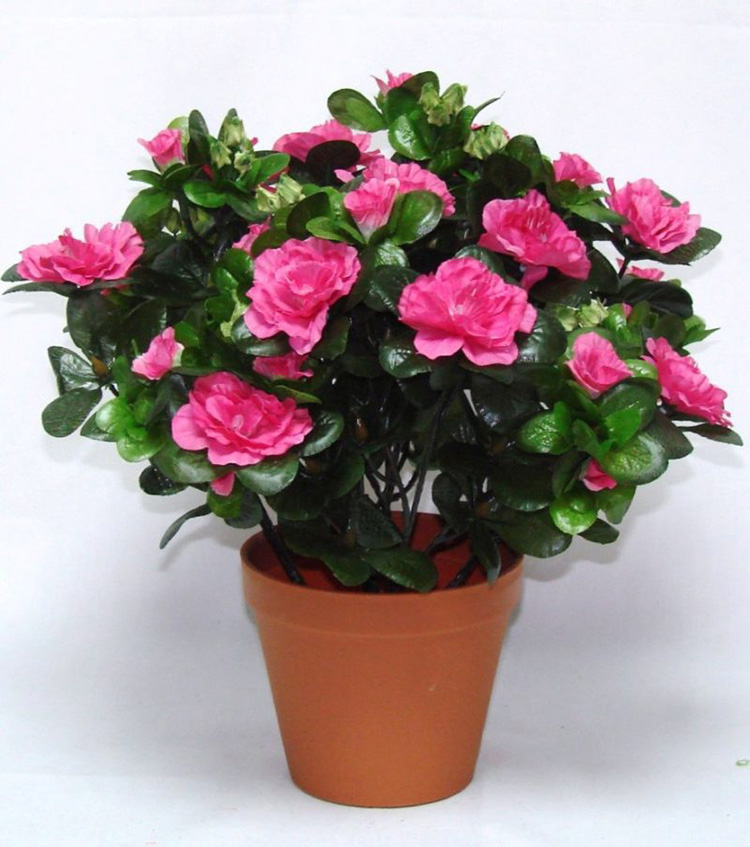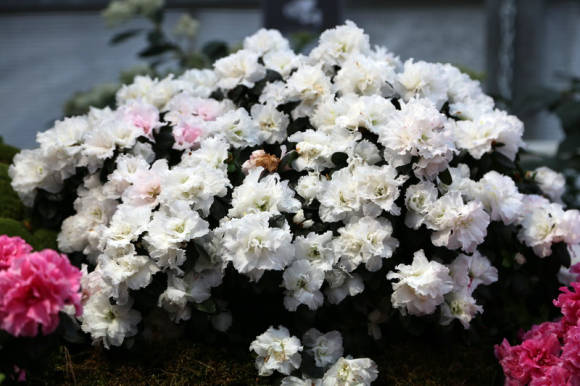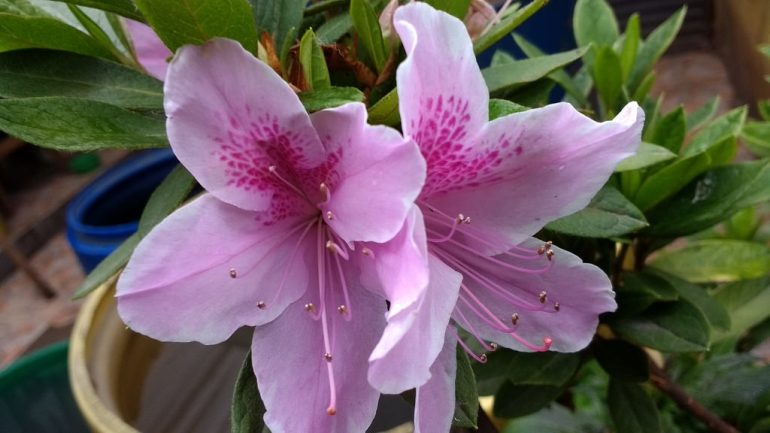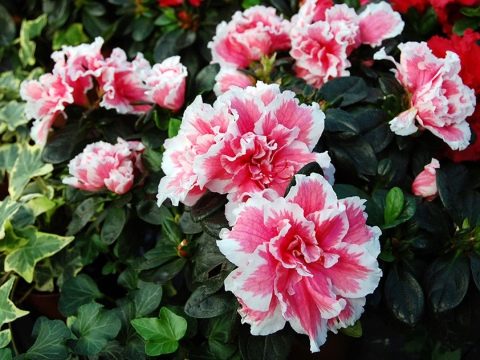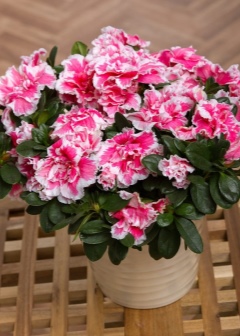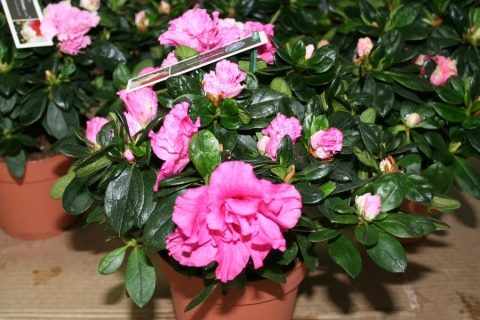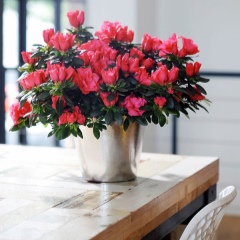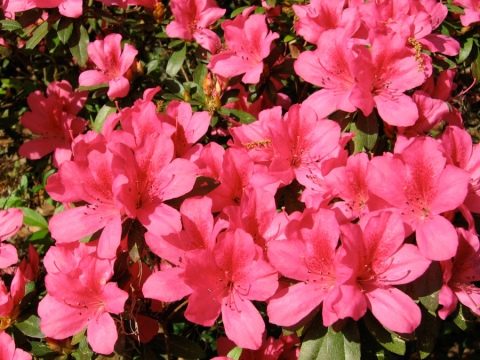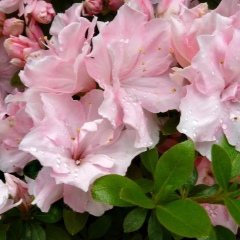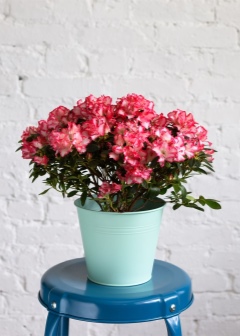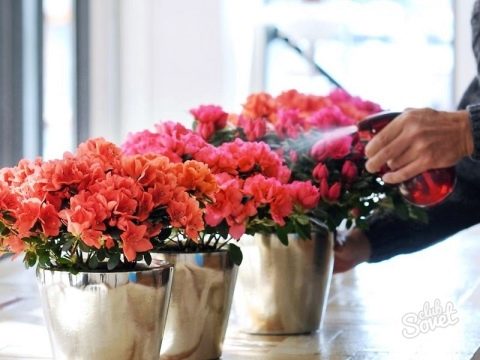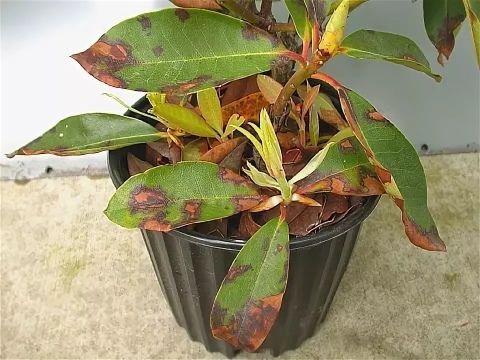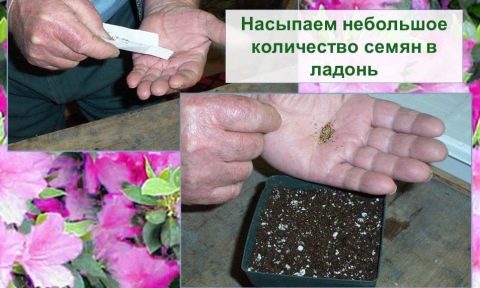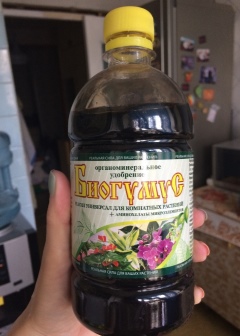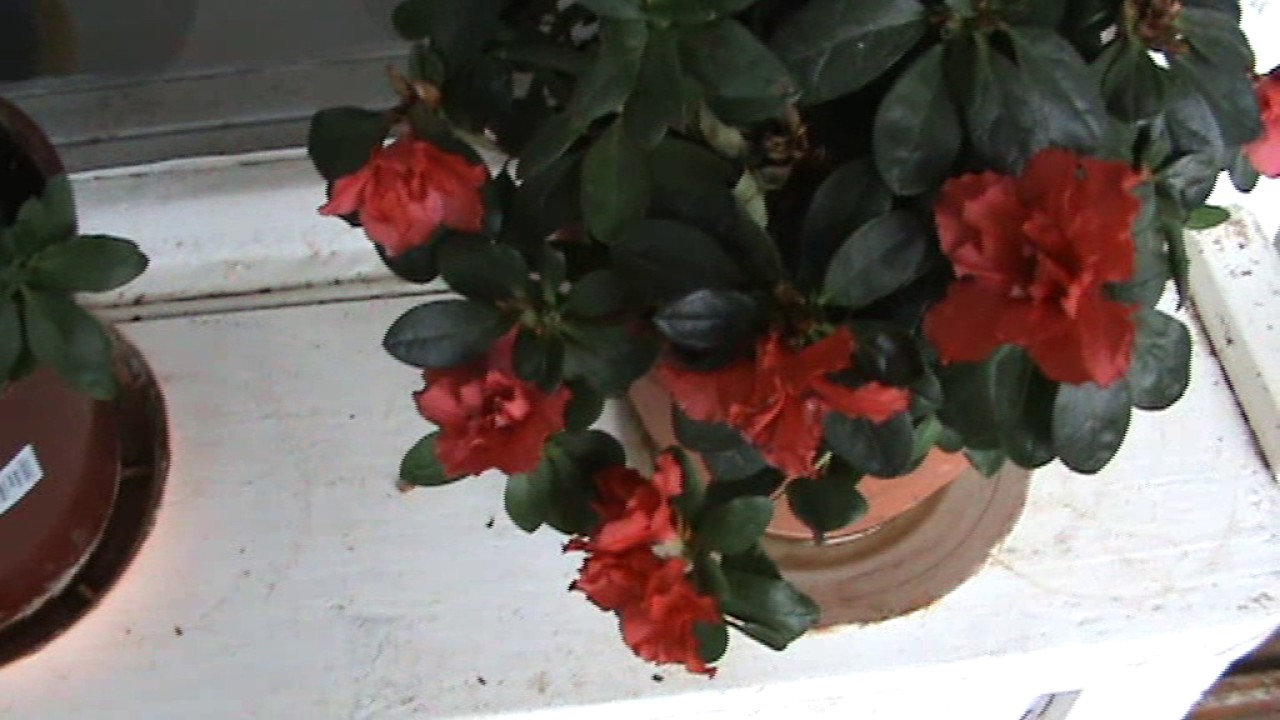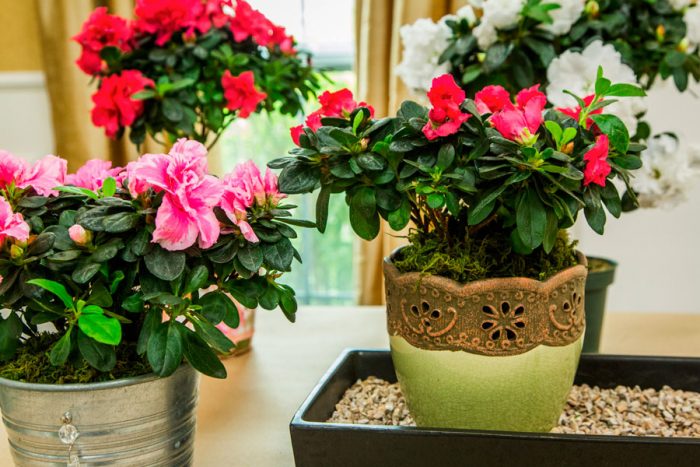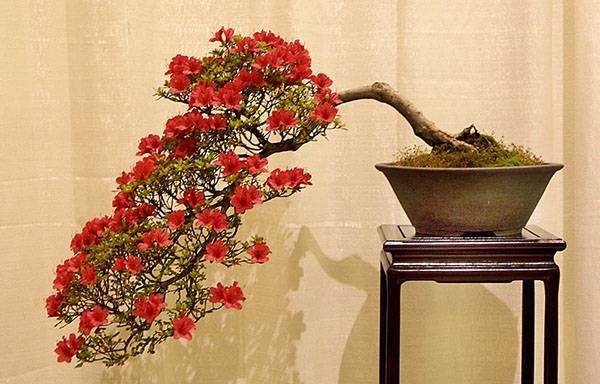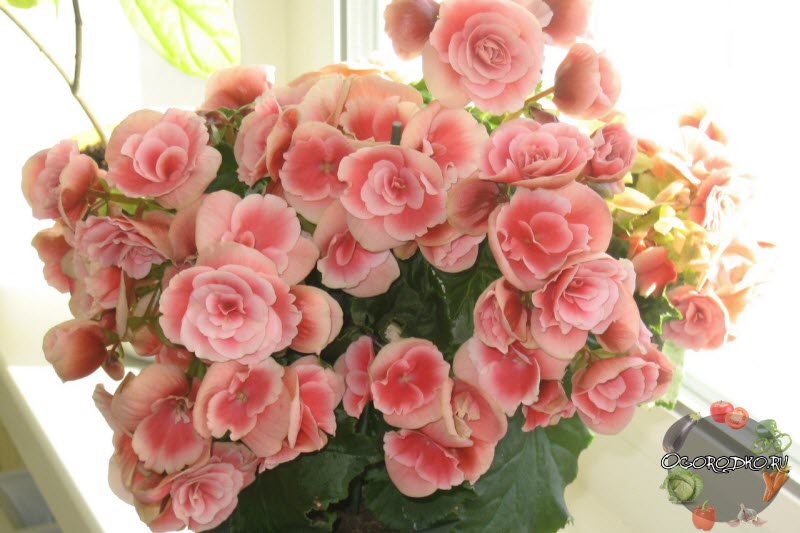3. Reproduction of azaleas
Vegetative propagation of azaleas with stem cuttings is possible, but cuttings rarely guarantee a positive result and rooting takes place for a long time. It is especially difficult for deciduous rhododendrons to reproduce in this way.
- Half-ripe cuttings 5 - 10 cm long with 2 - 3 internodes are soaked for several hours in a solution of growth hormones.
- Previously, the upper layer of bark is removed from the lower end of the cutting to a height of about 2 cm.
- When rooting, the buds and lower leaves are removed from the cuttings so that the plant does not lose moisture abundantly.
- Cuttings are planted in a nutritious acidic substrate - for example, in peat mixed with sand to a depth of about 1.5 - 3 cm.
- The soil around the planted cuttings is carefully compacted.
- From above, the cuttings are covered with a transparent plastic bag, glass or plastic cap to maintain uniform moisture
- Plants are periodically ventilated, gradually increasing the time. The shelter is removed only after 3 - 4 months, when there is confidence in successful rooting.
- In the room where rooting takes place, the air temperature should be 24 - 26 ° C., it is advisable to use bottom heating.
- Small bushes should not be exposed to direct sunlight.
- The first pruning is carried out when young plants reach a height of 10 - 12 cm.
Do not use too old shoots for cuttings - they will not take root.

Rhododendrons also reproduce by air layers - for this, long branches located close to the ground are bent, pinned and slightly covered with soil.
After a while, roots appear in the leaf node of such layers.
The successful completion of the rooting process will be indicated by a new growth that has appeared within 2 - 3 months.

The most rarely used breeding method is growing azaleas from seeds. The fact is that plants obtained in this way may not inherit all the varietal attractiveness of their parents, and the first flowering will occur only at the age of 3-4 years.
The highest percentage of germination is observed in fresh seeds.
- Sowing is carried out in the spring in a light, well-moisturized and nutritious substrate.
- From above, the seeds are only slightly pressed into the ground, without covering them with a layer of soil from above.
- Instead of watering, spray moistening is used with softened water at room temperature.
- The seedlings are covered with a transparent plastic cap or glass on top to maintain an evenly high level of humidity and placed in a well-lit place without exposure to direct sunlight, at a temperature of about 20 ° C.
- The first shoots can be seen within 3 to 4 weeks.
- With the appearance of the first shoots, the seedlings are ventilated, gradually increasing the time from several minutes a day.
- Watering is carried out lower - in the drainage holes of the container.
- Young plants will need a long day of light, so it is advisable to arrange artificial lighting for them.
- The sprouts dive into separate cups with the appearance of the first true leaves.
One of the positive aspects of this method of reproduction is the receipt of flowers, initially adapted to room conditions.
If the seedlings are grown for open ground, then the young bushes are taken out into the street for the first time at the age of 3-4 years, gradually hardening and accustoming them to new conditions of detention.

What conditions are required?
When planning to propagate this beautiful ornamental plant, it is important to pay attention to the quality of the planting material. It must be sourced from a healthy, mature and well-developed plant that is adapted to housekeeping.Too young and weak plants are not suitable for obtaining planting material, since they have a low donor potential
Very mature and old azaleas are also almost not used for the procedure, since at this age stage their metabolic processes slow down, nutrients, micro- and macroelements are less absorbed. Together, these factors make older plants unsuitable for reproduction.
Too young and weak plants are not suitable for obtaining planting material, since they have a low donor potential. Very mature and old azaleas are also almost not used for the procedure, since at this age stage their metabolic processes slow down, nutrients, micro- and macroelements are less absorbed. Taken together, these factors make older plants unsuitable for reproduction.
Another equally important condition on which the results of the upcoming event depend is the quality of the soil mixture. Its composition and properties are of equal importance both when breeding an azalea with seeds, and when propagating it by cuttings or dividing a bush.
Before use, the soil must be carefully processed: steam or disinfect with a solution of potassium permanganate.
If sand is used as part of the soil mixture, it must first be sieved, washed and calcined.
Other conditions that provide effective breeding of indoor azaleas are:
- creating a greenhouse effect;
- maintaining sufficient air humidity;
- ensuring a stable temperature regime.
The greenhouse effect is essential for seed germination and rooting of cuttings. It can be provided with the help of an impromptu greenhouse made of a plastic bottle cut in half, a container with a lid or plastic wrap, which is tightened with a container with planting material.
Considering that this ornamental culture is moisture-loving, it is important to ensure sufficient air humidity when breeding it. This can be done by periodic spraying and irrigation.
You can also maintain the required level of moisture in the air using a special room humidifier or a wide container filled with water and placed next to the plants.
When calculating to propagate an azalea in one of the ways, it is also necessary to take into account that many of its varieties have increased requirements for the air temperature.
Despite the fact that to date, breeders have managed to obtain cold-tolerant hybrids, when breeding azaleas, it is still desirable to maintain the temperature at 22-25 °.
Features of azalea
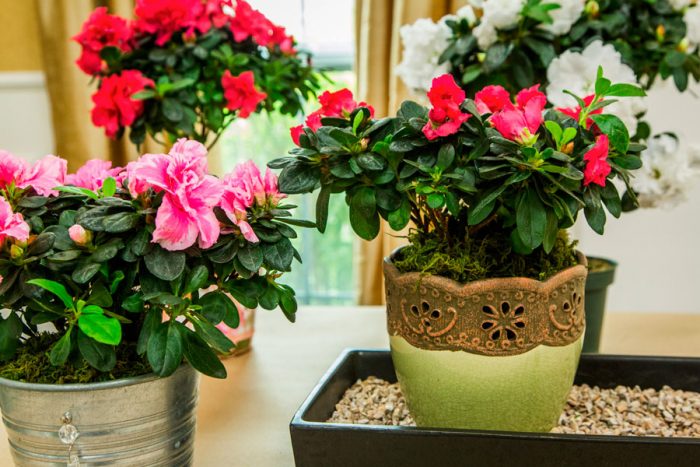
Azalea is a dwarf flowering plant that is branched and evergreen. It comes from China and Japan, but in nature this plant can be found in North America and in southern Europe. This indoor flower belongs to the genus of rhododendrons. From the Greek language "rhodon" is translated as "rose", and "dendron" - "tree". Therefore, rhododendron can be translated as "rosewood". In translation from the ancient Greek language "azalea" means "dry". The name of this plant is associated with its appearance, it is a small dry shrub.
Azalea appeared on the territory of Russia only at the beginning of the twentieth century, and at first it was grown only in greenhouses or botanical gardens. In natural conditions, there are about 350 species of this plant. However, only two of them are grown at home, and Indian azalea is the most popular. This species is an evergreen shrub, the height of which does not exceed half a meter. Short petiolate small leaf plates of a dark green color, their length is no more than 35 millimeters. There are pale red hairs on the surface of the leaves. Flowering is observed in winter, with flowers reaching 30-50 millimeters across.Japanese azalea is also an evergreen shrub, its height can vary from 0.3 to 0.5 meters. Its glossy leaf plates are very small. This species differs from the previous species in the size of the flowers, they are much smaller. This species can be grown in the garden.
The bloom of a room azalea is distinguished by its splendor. She begins to bloom at the age of 3 or 4 years. Most often, her flowers are painted in a deep pink color, but they can be bright red, lilac, snow-white, purple, and there are also two-color ones. In flowers, petals are weakly double, double and even. Dark green leaf plates are relatively small.
If you are buying a lush blooming azalea bush, then in this case it is recommended to choose one that has many unopened buds. The fact is that such a flower adapts to new conditions much faster, and its flowering will be long, lush and spectacular. Another purchased copy must be thoroughly examined, while trying to identify signs of disease or the presence of pests, if any. Tilt the bush slightly, if you see dried leaves, this may mean that the flower is sick or has been improperly looked after.
Bloom
Azalea blooms once a year in spring. According to the flowering period, it can be divided into 3 groups - early, middle and late.
The first group blooms in the middle of winter, the second - in the horse of winter - early spring, the third - in spring.
In young plants, repeated flowering is possible, which occurs after a few months.
The buds are laid in the fall; by the winter, the buds of the plant are usually already formed. During the period of bud appearance and flowering, it is necessary to strictly adhere to the temperature and watering regime.
For the appearance of a large number of flowers, the azalea must be cut and pinched - the more luxuriant the bush, the fewer of them.
Placing it in a cool place will increase the flowering time. This is facilitated by the timely removal of wilted flowers and seed bolls.
Pruning
Azaleas are usually given a spherical shape, and can also be designed as a standard tree or bonsai.
Pruning and shaping is recommended immediately after flowering. Because azalea grows rather slowly, there is no need to prune annually. Mainly empty or unnecessarily long shoots are shortened to maintain a spherical shape. Since the buds begin to form a short time after flowering, the plant is not cut from the end of summer until the next flowering. The early varieties are pruned in March-April, the late ones in May-June.
It should be trimmed with a sharp secateurs, pre-treated with alcohol. Pinching is done at a height of 10-12 cm from the ground, side shoots are also pinched, turning the bush so that the branches grow evenly.
If you are not able to provide all the required conditions, then treat it like a bouquet. At the end of the flowering period, give the plant to those who can fulfill all of its special maintenance requirements.
Winter care
Since the plant blooms precisely in the winter months, during this period there is no special specificity in the care. In the fall, the azalea should be moved to a cool place with less watering and feeding.
Read about how to cover and prepare an azalea for wintering here.
Types and varieties
For home growing, amateur flower growers prefer to choose mainly 2 types of azaleas - Indian and Japanese, but they also present many interesting opportunities for the implementation of creative ideas in creating home collections, since breeders, with their painstaking work, managed to bring out many varieties of these plants with various decorative properties. ...The Indian species of azaleas (Sims rhododendron) is a compact bushes (up to 50 cm) with different flowering periods, has a varied color of inflorescences and differs in the shape and size of flowers. Widespread.
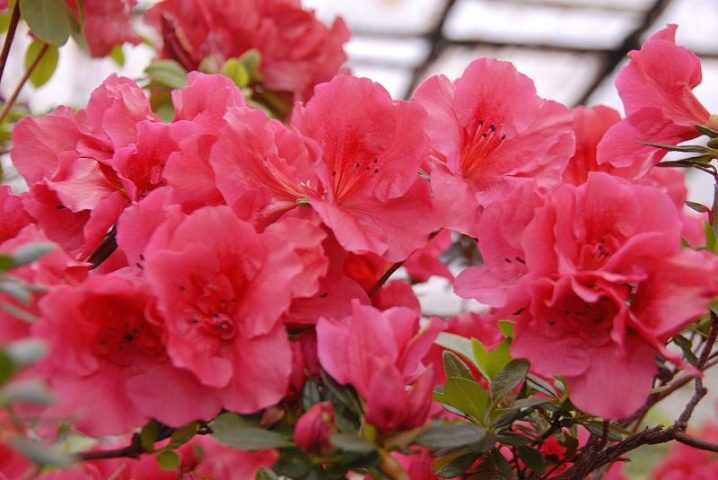
The Japanese species of azaleas (blunt rhododendron) have a very abundant lush flowering. The formed crown of a small bush (30-50 cm) during the flowering period is literally strewn with flowers, which ensured the high popularity of hundreds of varieties of this species among florists. The main difference between the Japanese azalea and the Indian one is the smaller flowers. In the spring, when the danger of frost has passed, pots of Japanese azalea can be taken out into the garden. It is possible to grow some varieties outdoors in gardens.
The existing varieties of azaleas are classified into groups:
- early flowering bloom at the very beginning of winter in December - January;
- mid-flowering ones will delight you with flowering in January - March;
- late blooming flowers begin to bloom at the end of the azalea flowering season in February - April.
Among the varieties of azalea, the most popular are Nabucco, Golden Lights, Pontiyskaya, Arima, Kiev Waltz, Snezhinka, Scarlet Flower, Melina.
Azalea selection
First you need to decide where to buy the plant. Azalea is very fragile and delicate, any little thing can damage successful development. That is why you need to go to a special nursery or greenhouse for azalea. Most flower shops are not equipped with different premises with a special microclimate for keeping different types of plants. While in the greenhouse, optimal conditions are maintained for the growth of each plant presented.
It is better to buy a plant before flowering, when several flowers have already opened and there are many buds on the bush.
- Firstly, the color and shape of the flower is immediately visible on such an azalea, and even an inexperienced grower will be able to understand what he is buying.
- Secondly, starting to care for an azalea from the time of flowering is much easier than bringing it into bloom.
The bush should be symmetrical, not trimmed, without visible damage, spots, cobwebs and other things.
Azalea indica mix - home care
These two species are the same in care, so all recommendations apply to both indica azaleas and indica mix azaleas (you can learn more about growing Mix varieties here).
Landing and placement
Due to the fact that the root system of this plant is superficial, a wide and shallow flowerpot is suitable for it.
It is important to choose the right place for the plant: it does not tolerate the direct sun and suffers from a lack of lighting
The best place for an indica azalea is in partial shade.
Priming
This moody plant loves acidic soil with a high organic content. For planting, you can prepare a mixture: mix coniferous, peat soil and river sand. In flower shops, you can find a special soil with high acidity, suitable for azaleas.
Watering
Particular attention should be paid to watering. It should be borne in mind that this plant constantly needs moist soil.
But it is also impossible to excessively overmoisten the earth. For watering, you should use boiled settled water. In summer, the plant requires abundant watering, in winter - reduced.
To constantly maintain the acidity of the soil, the water for irrigation must be acidified.
Air humidity
High humidity is what azalea loves so much. To maintain the correct mode, frequent spraying from a spray bottle is needed. Loves azalea and cool showers.
Fertilizing and feeding.
Azalea indica needs feeding once every two weeks in the spring and summer. It is recommended at this time to apply special complex fertilizers for azaleas. In autumn and winter, for better budding, you should fertilize the azalea with superphosphate.
Temperature regime
The hardest part of growing an azalea best is keeping it cool. In the autumn-winter period, the temperature should not exceed +12 + 15C, and in the spring and summer it should not rise above + 20C.At the same time, in autumn, the temperature must be reduced to +6 + 8C for abundant and long flowering.
Bloom
- The flowering period. Azalea indica and indica mix usually bloom from November to May. But sometimes, with proper care, the plant can bloom in the summer.
- Preparation for flowering.
The more lush and abundant the foliage on the bush, the worse and weaker the flowers will be.
To get beautiful flowers, you need to pinch the stems correctly. Pinch young stems, leaving no more than 5 leaves.
- Features of care during flowering. Although azalea indica is an extremely wayward plant, it can be rearranged during flowering, the inflorescences will not disappear from this. Faded flowers must be removed immediately, then the flowering will be longer.
- Leaving after flowering. The resulting seeds must be removed, they weaken the plant. Also during this period, you need to trim the flower.
Should the plant be pruned?
After flowering, it is necessary to cut off last year's, densely growing and underdeveloped shoots. For a beautiful formation of the bush, it is necessary to shorten the stems that are strongly protruding forward.
Transfer
Many growers ask themselves the question: "Is it necessary to transplant an azalea indica immediately after purchase?"
If the plant is in a state of flowering, but definitely not.
It is necessary to transplant an azalea indica mix every 3 years after the end of flowering. The transplanted azalea is placed in a darkened place. After about 4 weeks, when the plant is rooted and gives young shoots, pruning and pinching must be done.
Reproduction methods
Azalea is propagated by cuttings. They are immediately planted in the ground and covered with glass. The cuttings are kept at a temperature of + 20C and in complete darkness. Watering is done with warm water. Within two months, the stalk takes root.
Breeding usually takes place in the summer.
You can divide the indica azalea by dividing the bush.
Smell
Azalea indica has no smell, so this plant is great for allergy sufferers.
Life span
With proper care, temperature and humidity conditions, this plant will grow and bloom for decades. Azalea is a long-term plant that can live up to 70 years.
Japanese azalea care
Temperature regime
In a private house for Japanese azalea there are many options for location, because it loves a cool temperature of 15-17 degrees, and before flowering 12-13 degrees, in summer it feels comfortable at 21-23 degrees. Fits perfectly into the winter garden. In the conditions of a city apartment, you can also find a place for it. For example, a glazed balcony, a cool corridor, or just a cold window sill. But here, too, neatness is needed, the plant cannot stand drafts.
Before flowering and in time for it, leaving is practically reduced to a minimum. Spraying at this time is not recommended, you do not need to prune. Timely watering with soft water without chlorine, diffused bright light in the morning and azalea will bloom profusely and delight others.
After flowering, some leaves may also wither, this is normal and the branches should be cut off a little.
Top dressing
Azalea blooms in winter, it must be fertilized in spring and summer. This plant very quickly depletes the soil and absorbs nutrients, so feeding is carried out every 2 weeks. You can use specialized fertilizers "For azaleas", or use a complex of fertilizers that do not contain calcium.
Azalea transplant
The young plant is transplanted every year after flowering. An adult azalea is transplanted once every 3-4 years, also after flowering.
Preparing quality soil for replanting is very important. Compliance with the acidity of the soil within the pH range of 4.5-5 is mandatory. Special packaged soil for azaleas perfectly combines a loose structure, moisture and air permeable, lightness and the recommended pH level.
Azalea has thin and very fragile roots. The root system is developed in such a way that the roots completely entwine the soil.Do not try to separate the roots from the soil. They load the azalea together with the earthen lump into a larger pot and fill up the earth.
There must be high-quality drainage at the bottom of the pot in order to prevent moisture stagnation.
Preparing for flowering
Beginning in May, it is necessary to prune the branches of the azalea. It is required to shorten last year's branches, and all weak and poorly developing branches and leaves are also cut off. It is necessary to form a bush evenly, otherwise the plant will lose its decorative effect.
A sharp pruner wiped with alcohol is used to prune branches.
Moisture and watering mode
A special moment when growing Japanese azalea is maintaining air humidity at the level of 75-80%.
The plant needs daily spraying with soft, settled water. On hot days, humidity is maintained in additional ways. For example, using a household humidifier. You can install a pot of azalea in a container of damp expanded clay.
Water the azalea as needed, depending on the external environment. In dry, hot weather, watering may be required daily and spraying several times a day; in cool weather, watering once a week is sufficient.
If in doubt if the plant needs watering, raise the azalea pot; if it is unusually light, then watering is needed.
How to take care of her?
Despite the fact that Indian azalea is considered one of the most beautiful and popular types of indoor plants, caring for it at home is not easy. The flower is considered very whimsical to growing conditions and requires maximum comfort. Therefore, after purchase, it should be provided with some care.
Lighting. The shrub does not tolerate the direct rays of the sun, it should be placed in places protected from bright light, otherwise it may die at the initial stages of its development. Window sills on the north, east or west side of the apartment are well suited for the plant.

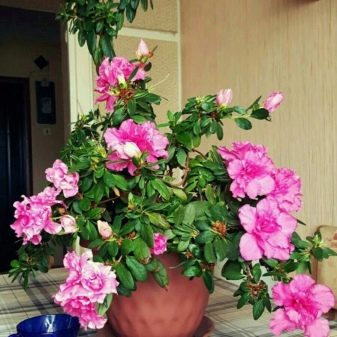
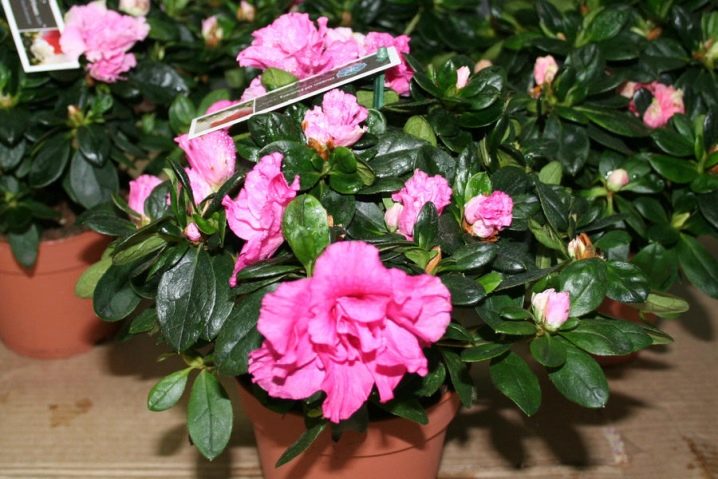

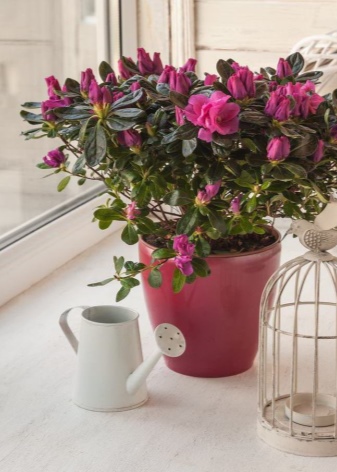





An important role in the care of a decorative flower is also played by its preparation for wintering. Azalea should be placed for this period in a room where the temperature regime is constantly maintained at least + 15 ° C. It is under such conditions that the plant will be able to "rest" well, gain strength and survive the winter without negative consequences. In order for the Indian azalea to please with its early flowering, in February it should be provided with top dressing, watering and additional artificial lighting. If you adhere to all of the above conditions in growing, then the Indian "beauty" will surely thank her owners with chic and fragrant flowers.
Indian azalea - home care
Lighting
It is necessary to provide bright, but at the same time, diffused light, completely without direct sunlight.
East and west windows are best suited.
During the "summer vacation" outdoors, the azalea should also be placed in a shaded area.
Temperature
The optimal temperature interval for summer time is from 18 to 24 degrees, in winter 10-14 degrees, a decrease to plus five is possible.
Drafts are not scary for Indian azaleas, and being outdoors from spring to autumn is very useful - but they need to be brought into the apartment before the central heating is turned on.
Air humidity
The plant needs well-humidified air and requires frequent spraying. During the flowering season, water spray should not fall on flowers and buds, as dark spots may appear on their delicate surface.
Priming
Good growth and development will be provided by a soil with a pronounced acid reaction. It is ready soil for azaleas or one of the following formulations:
two parts of coniferous land, one part of peat and some coarse sand;
peat, leaf, heather and coniferous soil in equal proportions with the addition of coarse sand.
Landing
A planting container with a drainage hole should be wide, but shallow for a shallow root system.
Its size should not be excessively large - azaleas develop slowly and the land not "mastered" by the plant will serve as a source of pathogenic processes.
At the bottom of the container, a drainage layer of expanded clay or small pebbles is required.
When planting, it is better to preserve as much as possible an earthen ball that protects the vulnerable root system.
When filling up the soil, you should pay attention to the position of the root collar: it should not be covered with earth, as this leads to the death of the plant.
Transfer
Young azaleas are transplanted annually, and mature ones - every 2-3 years, while the new pot should not be much larger than the previous one.
The method of transplantation should be transshipment - with complete, if possible, preservation of the old earthen coma.
Watering
The soil should be constantly kept moist, watering after its top layer dries out, but avoiding the excessive, stagnant presence of moisture.
You need to use soft water - well-settled tap water, or even better - rainwater, thawed, river water, but, in any case, not cold. To maintain the acidic reaction of the soil, several crystals of citric acid are periodically added to the irrigation water.
Loosening of the soil is unacceptable: delicate thin roots located directly under the soil surface will certainly suffer.
Top dressing
In the spring-summer period of active growth, once a week, Indian azaleas are fed with a fertilizer intended for them, containing ammonium salts - sulfate and nitrate, superphosphate and potassium sulfate.
In autumn and winter, during the period of laying and forming buds, superphosphate feeding is recommended.
Growth and pruning
The annual growth of these plants is very small; these are stayer plants designed for a very long life.
However, they also need pruning. It is carried out after flowering, forming a crown in the form of a bush or tree, removing overgrown or weak shoots.
Young summer and fall shoots are also pruned to create the conditions for abundant flowering.
The ability of azaleas to grow for a long time, bloom effectively and respond to pruning by growing a crown of the desired shape makes it a favorite of Japanese bonsai masters.
Bloom
The flowering seasons, depending on the variety, are December-January, January-March and February-April.
To make sure it is timely and abundant, they carry out the following preparation:
immediately after flowering, in May, azaleas are cut off, and on young shoots, pinching them, retain 4-5 leaves. Remove those shoots that appear next to flower buds
in October-December, when flower buds are laid, the plants are kept at 6-10 degrees, and in January-February, to stimulate flowering, at 15-17.
Flowering will be longer if, after the opening of the first flowers, the temperature is slightly reduced, and what has faded is regularly removed.

